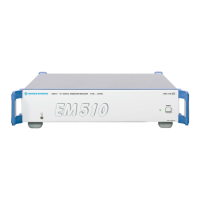Remote Control via LAN EM510
5.125 4065.7763.32-01.00
Sockets:
The remote clients are connected to the host computer by so-called sockets. These are logic point-to-
point links that are independent of the transmission medium used. Sockets are based on the
Transmission Control Protocol (TCP) or the User Datagram Protocol (UDP, not used in EM510 ). These
two protocols are in turn based on the Internet Protocol (IP). The following figure shows the layer model
of the sockets.
Sockets
TCP UDP
IP
Ethernet
The transmission media are located beneath the IP layer.
The use of sockets has several advantages:
the protocols used (PPP, IP, TCP, UDP) are standardized and implemented on all customary
operating systems (WindowsNT, Windows95, Windows 3.1, UNIX, SunOS, and many more).
TCP links are protected against transmission errors.
Host software can be generated independent of the transmission medium used (LAN or RS232).
Several logic links may use the same transmission medium.
IP routing enables access also to remote units and over great distances (e.g. via the Internet).
When the unit is started, a so-called list socket is generated. It functions as the unit's "receptionist".
Each host wishing to remote-control the EM510 has to log in with the list socket first. The list socket
then generates a new remote client and allocates the link to a new socket so the list socket remains
free to receive further hosts.
For login at the list socket, the host needs to have the address and port number of the unit. This can be
set in the Setup Remote menu.

